On August 6, the world marks Hiroshima Day and the International Day of Nuclear Disarmament. On that day in 1945, the US Air Force dropped nuclear bombs on the Japanese city of Hiroshima. Each year on the same day, Hiroshima holds a commemoration ceremony.
Despite being shadowed by the tragedy, the cities have lived on. Take a look at the then and now of Hiroshima and Nagasaki – in our photo gallery.
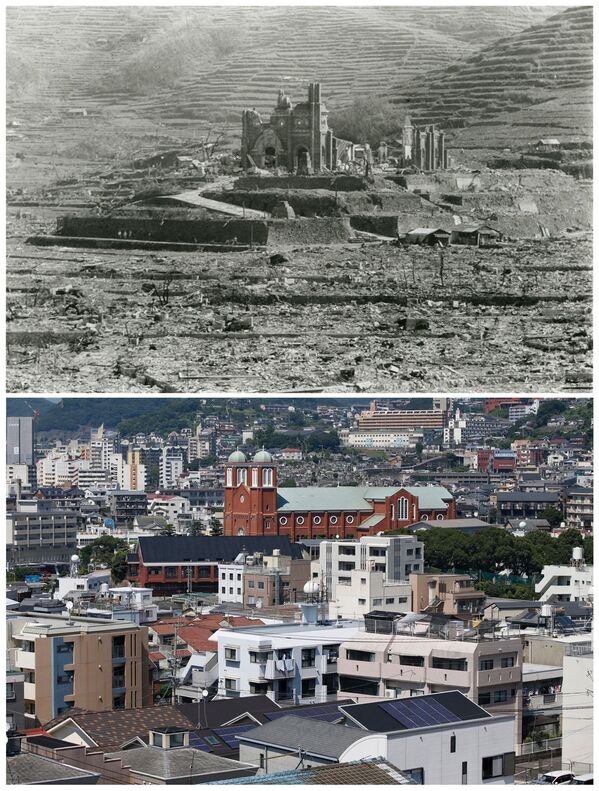
Nearly 74,000 people were killed by the blast in Nagasaki. Over half of the victims had burns, and up to 30 percent were injured by the shock wave. About 20 percent were affected by the nuclear radiation that was released.
Above: A combination picture shows the Urakami Cathedral (center), which was destroyed by the atomic bombing of Nagasaki on August 9, 1945, in this undated handout photo taken by Shigeo Hayashi and distributed by the Nagasaki Atomic Bomb Museum (top), and the rebuilt cathedral on July 31, 2015.
Above: A combination picture shows the Urakami Cathedral (center), which was destroyed by the atomic bombing of Nagasaki on August 9, 1945, in this undated handout photo taken by Shigeo Hayashi and distributed by the Nagasaki Atomic Bomb Museum (top), and the rebuilt cathedral on July 31, 2015.
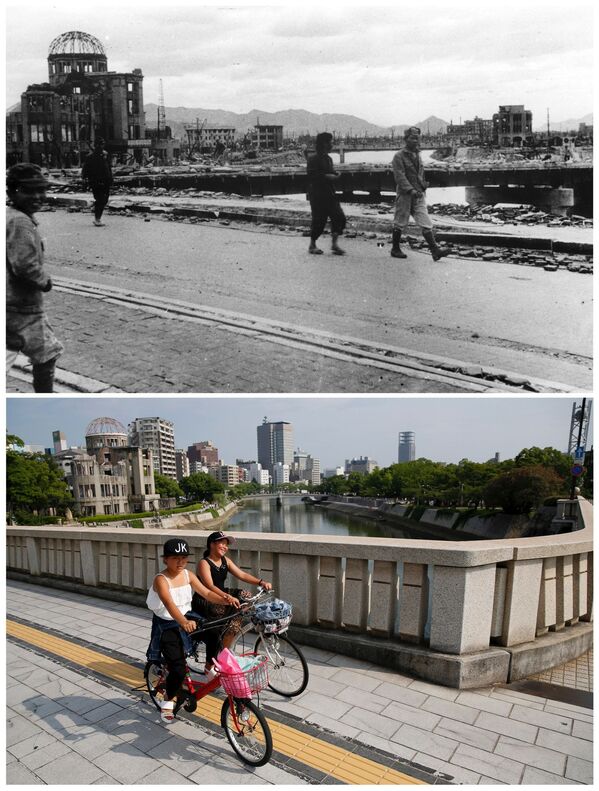
In Hiroshima, the blast instantly killed about 80,000 people and wounded 40,000. Over 12,000 were never accounted for. All buildings within in an area of over 4.6 square miles were destroyed; of 90,000 buildings in the city, 62,000 were razed.
Above: A combination picture shows the gutted Hiroshima Prefectural Industrial Promotion Hall (left), in this handout photo taken by Shigeo Hayashi in October 1945 and released by the Hiroshima Peace Memorial Museum (top), and the same location on July 28, 2015.
Above: A combination picture shows the gutted Hiroshima Prefectural Industrial Promotion Hall (left), in this handout photo taken by Shigeo Hayashi in October 1945 and released by the Hiroshima Peace Memorial Museum (top), and the same location on July 28, 2015.

The two blasts accounted for about 300,000 victims (dead or missing), while approximately 200,000 people suffered from radiation burns or poisoning.
Above: A combination picture shows the south face of Urakami Cathedral, which was destroyed by the atomic bombing of Nagasaki on August 9, 1945, in this undated handout photo taken by Hisashi Ishida and distributed by the Nagasaki Atomic Bomb Museum (top) and the rebuilt cathedral, July 31, 2015.
Above: A combination picture shows the south face of Urakami Cathedral, which was destroyed by the atomic bombing of Nagasaki on August 9, 1945, in this undated handout photo taken by Hisashi Ishida and distributed by the Nagasaki Atomic Bomb Museum (top) and the rebuilt cathedral, July 31, 2015.
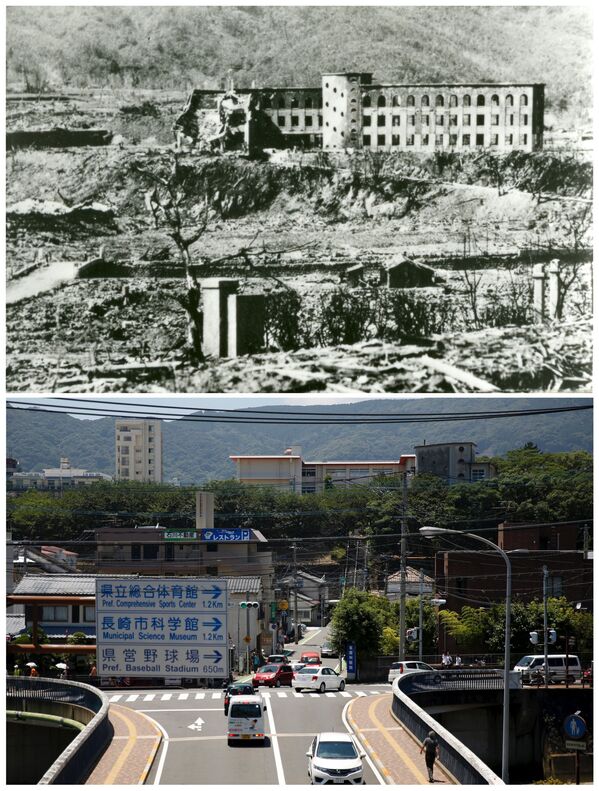
The Little Boy bomb, with a uranium charge equivalent to 13,000-18,000 tons of TNT, was dropped on Hiroshima at 8:15 a.m. local time. It exploded at an altitude of about 0.37 miles (600 meters) above the ground.
Above: A combination picture shows the ruins of the Shiroyama National School, which was destroyed by the atomic bombing of Nagasaki on August 9, 1945, in this undated handout photo taken by Shigeo Hayashi and distributed by the Nagasaki Atomic Bomb Museum (top), and the same location on July 31, 2015.
Above: A combination picture shows the ruins of the Shiroyama National School, which was destroyed by the atomic bombing of Nagasaki on August 9, 1945, in this undated handout photo taken by Shigeo Hayashi and distributed by the Nagasaki Atomic Bomb Museum (top), and the same location on July 31, 2015.

Through the bombings, the US primarily pursued the political goals of demonstrating its power using nuclear weapons to intimidate other nations and ensure its own strategic superiority.
Above: A combination picture shows the etched shadow of a passerby that was imprinted on the road surface of Yorozuyo Bridge, due to the heat of the atomic bombing of Hiroshima on August 6, 1945, in this handout photo taken by the US Army between October and November 1945 and distributed by the Hiroshima Peace Memorial Museum (top), and the same location.
Above: A combination picture shows the etched shadow of a passerby that was imprinted on the road surface of Yorozuyo Bridge, due to the heat of the atomic bombing of Hiroshima on August 6, 1945, in this handout photo taken by the US Army between October and November 1945 and distributed by the Hiroshima Peace Memorial Museum (top), and the same location.
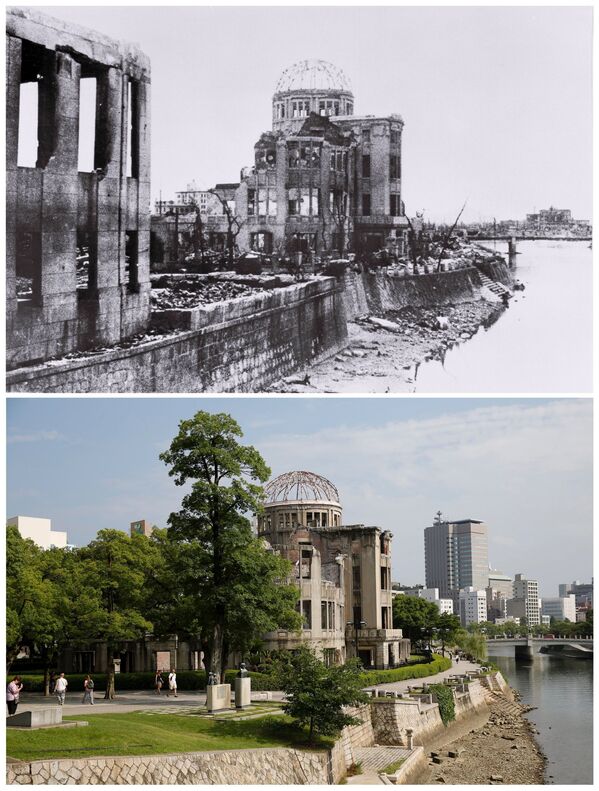
In the center of Hiroshima, a piece of land with ruins was left unrestored to keep the memory of the tragedy.
Above: A combination picture shows the gutted Hiroshima Prefectural Industrial Promotion Hall in Hiroshima after the atomic bombing on August 6, 1945, in this handout photo taken by Masami Oki on August 20, 1945 and distributed by the Hiroshima Peace Memorial Museum.
Above: A combination picture shows the gutted Hiroshima Prefectural Industrial Promotion Hall in Hiroshima after the atomic bombing on August 6, 1945, in this handout photo taken by Masami Oki on August 20, 1945 and distributed by the Hiroshima Peace Memorial Museum.
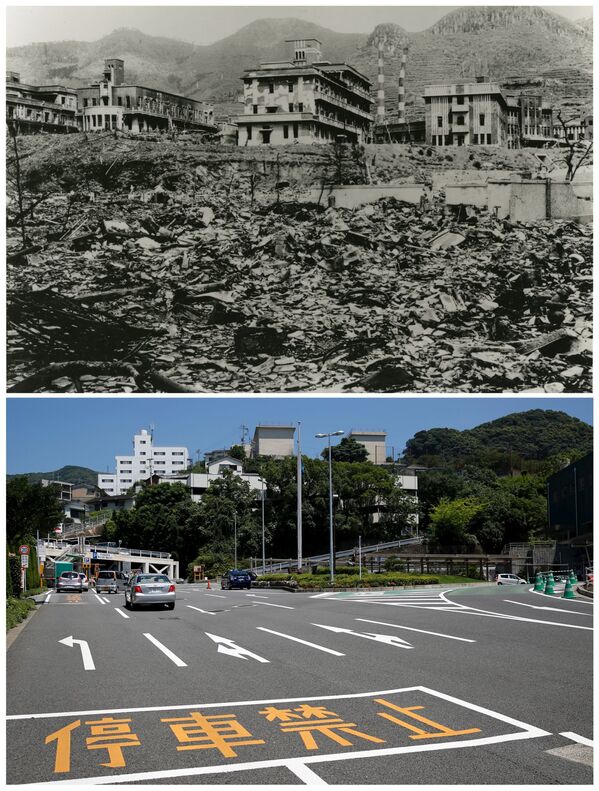
The Fat Man bomb was dropped on Nagasaki at 11:01 a.m. on August 9. It had a plutonium charge equivalent to about 20,000 tons of TNT. The irregular terrain and a 1.2 mile deviation from the target (the center of the city) slightly reduced human loss and destruction.
Above: A combination picture shows the ruins of Nagasaki Medical College, destruction caused by the atomic bombing of Nagasaki on August 9, 1945 in this undated handout photo taken by Torahiko Ogawa and distributed by Nagasaki Atomic Bomb Museum (top) and the same location on July 31, 2015.
Above: A combination picture shows the ruins of Nagasaki Medical College, destruction caused by the atomic bombing of Nagasaki on August 9, 1945 in this undated handout photo taken by Torahiko Ogawa and distributed by Nagasaki Atomic Bomb Museum (top) and the same location on July 31, 2015.
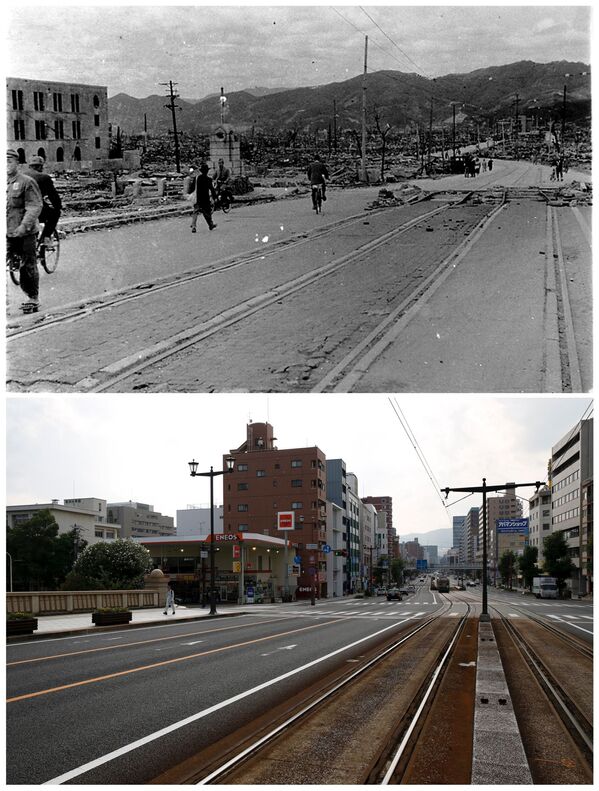
The nuclear bombings of Hiroshima and Nagasaki are, and hopefully will remain, the only examples of combat use of nuclear weapons in human history.
Above: A combination picture shows local residents walking near Aioi Bridge in Hiroshima, after the atomic bombing of Hiroshima on August 6, 1945, in this handout photo taken by Shigeo Hayashi in October 1945 and released by the Hiroshima Peace Memorial Museum (top), and the same location on July 28, 2015.
Above: A combination picture shows local residents walking near Aioi Bridge in Hiroshima, after the atomic bombing of Hiroshima on August 6, 1945, in this handout photo taken by Shigeo Hayashi in October 1945 and released by the Hiroshima Peace Memorial Museum (top), and the same location on July 28, 2015.

